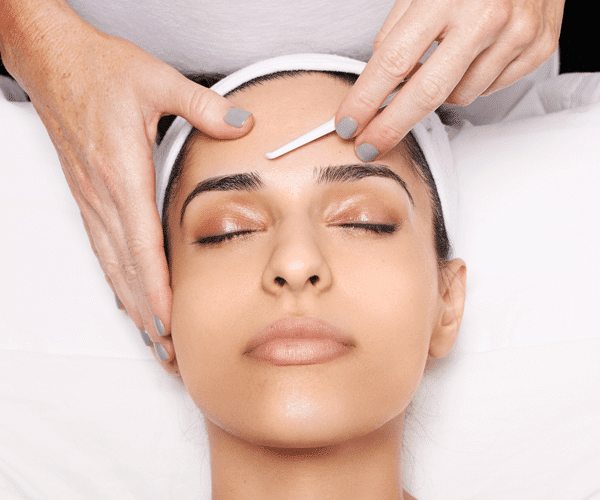For women who have been searching for a way to remove hair from their face, dermaplaning may just be the answer. This popular skin care treatment exfoliates the skin, removing dead skin cells from the face, as well as fine vellus hairs (aka peach fuzz). Under this definition, dermaplaning sounds a lot like just shaving your face, but the process goes far beyond that in its procedure and its benefits.
Unlike traditionally shaving your face, dermaplaning is best done by a dermatologist or aesthetician. Using a small surgical scalpel, they gently scrape away dead skin cells and wispy facial hair. If you feel your complexion is dull, flaky, or prone to breakouts due to clogged hair follicles, this may be just the treatment for you. Dermaplaning evens out the tone and texture of skin, leaving you with a healthy glow.
Want to learn more about this fascinating new beauty trend? Keep reading to have all your questions about dermaplaning answered.
What Can I Expect from a Dermaplaning Treatment?

Before beginning the procedure, many dermatologists or aestheticians will cleanse and gently exfoliate your skin, as the blade needs to be applied to clean and dry skin. Using a 10-inch scalpel, they will gently scrape across the forehead, cheeks, chin, nose, and neck. Dermaplaning is frequently used alongside other treatments, such as microdermabrasion, skin peels, or ablative lasers. These other treatments can enhance the process and provide added benefits to your skin, leaving it brighter and smoother.
The whole treatment takes only 15 minutes or so, and your skin can bounce right back. Doctors say that some redness can be expected, but it should not keep you from going about your day as usual. It should be noted that those with sensitive skin may have more redness or irritation. Prices of dermaplaning vary depending on the provider and the other add-on treatments, so you can expect to spend anywhere between $50 and $250. If the price point is important to you, you can shop around, just be sure to find a licensed professional who will take good care of your skin.
What Will My Skin Be Like Post-Treatment?

The beauty of a dermaplaning treatment is that you will see an instant improvement in your skin texture and tone. Your skin will be brighter, smoother, glowing, and even appear more youthful. Long-term, you can expect to see other benefits such as fewer wrinkles, a reduction in dark spots and acne scarring, and an increased cell turnover.
Another benefit of dermaplaning is that makeup will go on your face much more smoothly. If you had trouble with uneven foundation application in the past, you will now have better results. Skin care products and treatments perform much more efficiently since your skin cells are fresh and can readily accept products.
Many people worry that a process like dermaplaning will make facial hair grow back thicker or darker, but that is definitely not the case. It is a myth that shaving causes hair to grow back thick and dark. Experts clarified that after a treatment like dermaplaning, hair growth might feel different because the hairs were cut straight across. A bluntly cut hair may seem thicker because the hairs do not have their natural point, but in reality, they are no thicker or darker than before treatment.
The most important thing to note following dermaplaning treatment is that your skin will be much more sensitive to the sun. It is essential to use a high SPF sunblock following treatment, and be diligent about reapplying if you plan to be outdoors. Just wearing makeup containing SPF will not be enough to protect this new skin.
Is There Anyone Who Shouldn’t Try Dermaplaning?
While nearly everyone can receive dermaplaning safely, there is some disagreement among experts about who are prime candidates for the treatment. However, everyone agrees that if you have acne, especially pustular acne, this treatment is not for you. There is a chance that the scalpel could nick a pimple, causing a longer healing process and possible scarring. It is also important to tell your provider if you have a history of cold sores so that they avoid the area and do not spread any infection.
There are a few other people who may want to avoid dermaplaning, although it is really up to them. If you have excess facial hair, some experts recommend treatments like waxing, threading, or laser hair removal instead. These processes may take longer or need more upkeep, but they will provide much more effective results.
Dermaplaning may need to be avoided if you have a hormonal imbalance, acne, pigmentation problems, or sensitive skin, as these things may become worse following the treatment. Those with inflammatory skin conditions like rosacea, eczema, and psoriasis may have trouble tolerating the procedure as well since it can irritate sensitive skin.
However, all these things are just warnings. If you are really interested in dermaplaning, make an appointment to meet with a dermatologist or aesthetician before the treatment so they can assess your skin and give you the best advice regarding what will work for you.
How Can I Maintain My Skin Following Dermaplaning?
Dermaplaning treatments can last up to four weeks, but since your skin is always regenerating, you should schedule an appointment every month or so if you are interested in maintaining the glowing results. In the meantime, you should take advantage of your newly freshened skin by using plenty of anti-aging products. Add a vitamin C or E serum to your morning routine and a retinol night cream to maximize the potential.

Can I Try Dermaplaning At Home?
While it is possible to find a variety of dermaplaning tutorials online, and it may seem easy to do, professionals warn against it. No drugstore blade will be as sharp or accurate as the surgical scalpel used by the pros. Plus, you do not want to risk cutting yourself and causing scarring. Leave dermaplaning to the experts. If you need a touch-up or small spot treatment between appointments, using something like the ever-popular Tinkle Razor may be your best bet.
Recap
Dermaplaninga quick and effective way






































